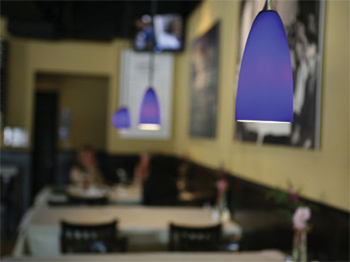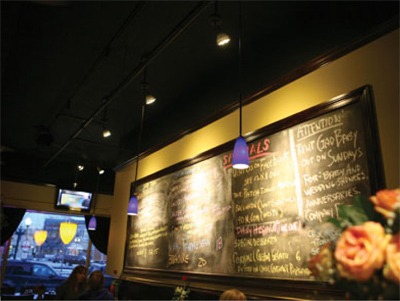In today’s commercial foodservice industry, issues like sustainability and energy efficiency are pushed to the back burner. Although restaurant owners and facility managers support the concept of green business practices, the pace of day-to-day operations and the perceived lack of real dollar value and ROI make energy-efficient strategies less urgent than other concerns.
But in a commercial foodservice operation, ignoring energy-efficient alternatives is like overpaying for common ingredients. Restaurants consume massive amounts of energy and even a few simple strategies can result in significant bottom line savings. The cost benefit potential of energy-efficient strategies is particularly relevant in lighting, where a transition to LED lamps and fixtures can yield as much as 60% energy savings on your lighting bill.
Energy Consumption in a Typical Restaurant
In general, restaurants are open longer and on more days of the week than typical commercial buildings. As a result, the government estimates that restaurants use five to seven times more energy per square foot than office buildings, retail stores and other structures.
Energy consumption rates are even greater in the high-volume, quick-service restaurants (QSR) industry. For many reasons, QSR facilities are estimated to consume as much as 10 times more energy per square foot than other commercial buildings.
 It’s not uncommon for restaurant lighting to be on for 16 to 20 hours a day, 7 days a week. So when it comes to lighting, high efficiency LED lighting can deliver considerable energy savings, maintenance savings and operational savings — all while creating a more attractive atmosphere and helping the world’s sustainability. LED technology has been used for years in exit signs and general signage for years, so why not transition now to general illumination?
It’s not uncommon for restaurant lighting to be on for 16 to 20 hours a day, 7 days a week. So when it comes to lighting, high efficiency LED lighting can deliver considerable energy savings, maintenance savings and operational savings — all while creating a more attractive atmosphere and helping the world’s sustainability. LED technology has been used for years in exit signs and general signage for years, so why not transition now to general illumination?
There are approximately 1 million restaurants in the U.S. If each restaurant replaced just one incandescent bulb with LED lighting, CO2 emissions would be reduced by more than 645 million pounds per year — equivalent to the annual greenhouse gas emissions from 57,400 vehicles. Just as importantly, the U.S. restaurant industry would save $40 million in energy costs every 12 months, according to ENERGY STAR.
Cost Advantages of LED
Performance improvement is a primary target in restaurant lighting projects. As the foodservice industry gradually moves away from traditional incandescent and fluorescent lighting, the expectation is that replacement solutions will deliver improvements in several key areas.
Restaurant managers frequently choose LED technology because it outperforms both fluorescent and incandescent lighting in energy efficiency, maintenance costs, disposal costs, visual appeal and light quality. LED retrofits usually pay for themselves within 2 years, allowing the restaurant to reap energy and maintenance savings for the remaining years of LED lamp life.
In an attempt to achieve energy savings and an environmentally friendly lighting program, a San Diego-based fast food franchise recently performed a retrofit in which recessed fixtures, fluorescent tubes and ballasts, and other traditional light sources were replaced with LED technology. The areas of retrofit include the order counter, cooking area, freezer boxes and the washroom (prep area).
As a direct result of the retrofit project, the operation achieved measurable gains in efficiency and light output. Footcandle readings increased substantially (more than doubling in some areas), and the restaurant received a 14.2 month ROI on the project, paving the way for sizeable efficiency gains on a go-forward basis.
LED lighting also generates much less heat than traditional, incandescent lighting fixtures. So in addition to saving 60% in direct energy costs, LED lighting creates savings in HVAC expenses and gives facility managers greater control over dining room atmospheres.
In the maintenance category, approximately 15% to 20% of standard fluorescent ballasts and 70% of fluorescent lamps need to be replaced annually, as mentioned by specialty engineering group Mazzetti, Nash, Lipsey, Burch. Incandescent lighting features similarly high burnout rates and requires regular maintenance.
LED lighting, on the other hand, is virtually maintenance free. LED lamps have an average life of 50,000 hours compared to an average of 8,000 hours for fluorescents and 1,200 hours for incandescents. The maintenance differential is even more pronounced when you factor in the cost of meeting the mercury-based disposal requirements for fluorescent lighting.
Finally, it’s important for facility managers, engineers, business owners and maintenance companies to understand that the transition from traditional lighting to more energy- efficient solutions can be accomplished in a manner that enhances the ambience and aesthetic requirements of nearly any restaurant environment. Rather than managing costs by choosing lighting fixtures that are efficient and attractive, today’s technology allows facility managers to accomplish both energy efficiency and spectacular dining ambience.
In 2011, Ciao Baby!, a family-owned Italian eatery in Barrington, Illinois, embarked on a LED lighting retrofit of the restaurant’s kitchen, dining area, storefront and restroom areas. From the outset of the project, management determined that a primary requirement of the new lighting solutions would be to enhance the restaurant’s ambience and visual style.
Using decorative pendant LED fixtures, spotlights (for menu boards and ornamental wall hangings), and other style- conscious lighting elements, Ciao Baby! dramatically improved light quality and dining atmosphere while generating more than $3,000 in annual energy savings.
The experience of Ciao Baby! demonstrates that foodservice facility managers no longer have to choose between appearance and function in energy-efficient lighting solutions. In a larger sense, these eateries are also proving that a focus on energy efficiency and sustainability can be a viable way to achieve cost savings and improve dining experiences.
For restaurant owners and facility managers, the key takeaway should be that in most cases, the cost benefits of lighting retrofits and other energy-efficient strategies significantly outweigh the expense it takes to perform environmentally friendly facility projects with retrofit products available today.

